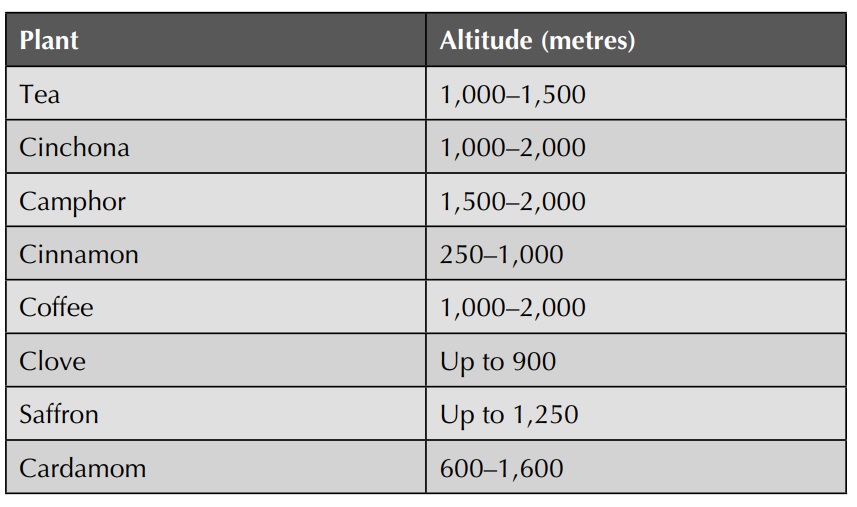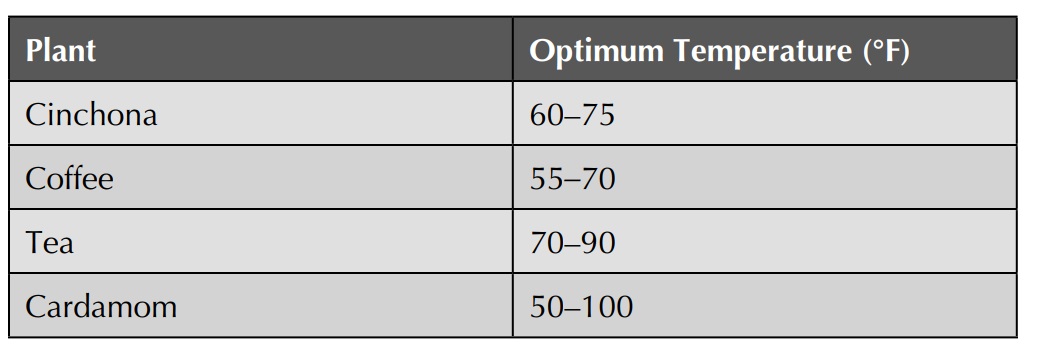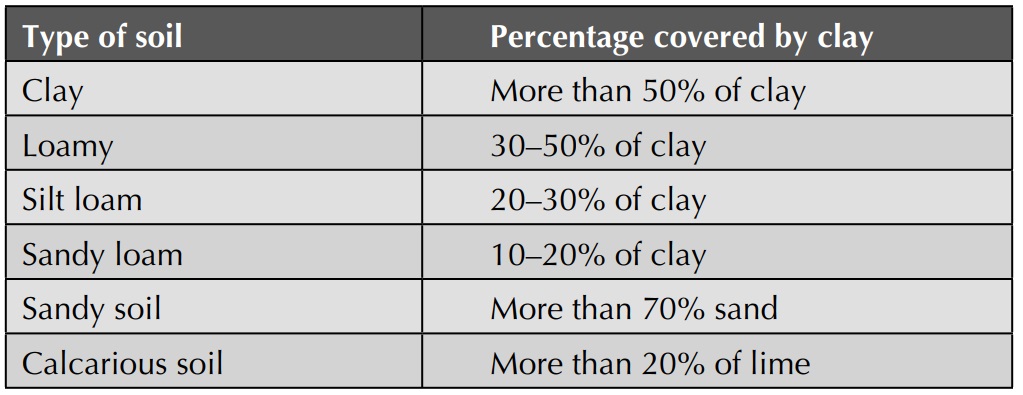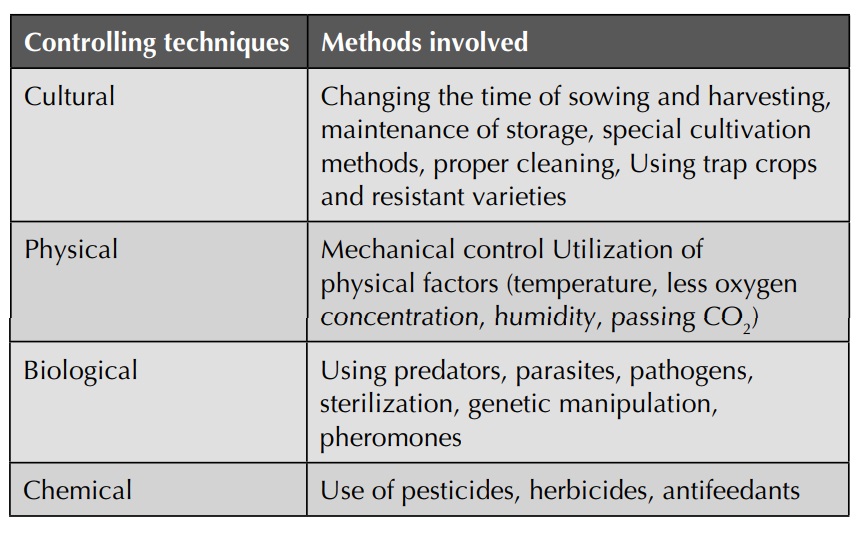Factors Affecting Cultivation
| Home | | Pharmacognosy |Chapter: Pharmacognosy and Phytochemistry : Cultivation, Collection and Processing of Herbal Drugs
Cultivation of medicinal plants offers wide range of advan-tages over the plants obtained from wild sources. There are few factors to concern which have a real effect on plant growth and development, nature and quantity of secondary metabolites. The factors affecting cultivation are altitude, temperature, rainfall, length of day, day light, soil and soil fertility, fertilizers and pests.
FACTORS AFFECTING CULTIVATION
Cultivation of medicinal plants offers wide range of
advantages over the plants obtained from wild sources. There are few factors
to concern which have a real effect on plant growth and development, nature and
quantity of secondary metabolites. The factors affecting cultivation are
altitude, temperature, rainfall, length of day, day light, soil and soil
fertility, fertilizers and pests. The effects of these factors have been
studied by growing particular plants in different environmental conditions and
observing variations. For example, a plant which is subjected to a particular
environment may develop as a small plant which, when analysed shows high
proportion of metabolite than the plants attained the required growth.
Nutrients have the ability to enhance the production of secondary metabolites,
at the same time they may reduce the metabolites as well.
Altitude
Altitude is a very important factor in cultivation of
medicinal plants. Tea, cinchona and eucalyptus are cultivated favour-ably at an
altitude of 1,000–2,000 metres. Cinnamon and cardamom are grown at a height of
500–1000 metres, while senna can be cultivated at sea level. The following are
the examples of medicinal and aromatic plants indicating the altitude for their
successful cultivation (Table below).

Temperature
Temperature is a crucial factor controlling the growth,
metabolism and there by the yield of secondary metabolites of plants. Even
though each species has become adapted to its own natural environment, they are
able to exist in a considerable range of temperature. Many plants will grow
better in temperate regions during summer, but they lack in resistance to
withstand frost in winter.
Table: Optimum Temperature for Drug Cultivation

Rainfall
For the proper development of plant, rainfall is required in
proper measurements. Xerophytic plants like aloes do not require irrigation or
rainfall. The effects of rainfall on plants must be considered in relation to
the annual rainfall throughout the year with the water holding properties of
the soil. Variable results have been reported for the production of
constituents under different conditions of rainfall. Excessive rainfall could
cause a reduction in the secondary metabolites due to leaching of water soluble
substances from the plants.
Day Length and Day Light
It has been proved that even the length of the day has an
effect over the metabolites production. The plants that are kept in long day
conditions may contain more or less amount of constituents when compared to the
plants kept in short day. For example peppermint has produced menthone, menthol
and traces of menthofuran in long day conditions and only menthofuran in short
day condition.
The developments of plants vary much in both the amount and
intensity of the light they require. The wild grown plants would meet the
required conditions and so they grow but during cultivation we have to fulfill
the requirements of plants. The day light was found to increase the amount of alkaloids
in belladonna, stramonium, cinchona, etc. Even the type of radiation too has
an effect over the development and metabolites of plants.
Soil
Each and every plant species have its own soil and
nutritive requirements. The three important basic characteristics of soils are
their physical, chemical and microbiological properties. Soil provides
mechanical support, water and essential foods for the development of plants.
Soil consists of air, water, mineral matters and organic matters. Variations in
particle size result in different soils ranging from clay, sand and gravel.
Particle size influences the water holding capacity of soil. The type and
amount of minerals plays a vital role in plant cultivation. Calcium favours the
growth of certain plants whereas with some plants it does not produce any
effects. The plants are able to determine their own soil pH range for their
growth; microbes should be taken in to consideration which grows well in
certain pH. Nitrogen containing soil has a great momentum in raising the
production of alkaloids in some plants.
Depending upon the size of the mineral matter, the following
names are given to the soil (Table 6.3).
Table : Type of soil on the basis of particle size.

Depending upon the percentage covered by clay, soils are
classified as under (Table below.).
Table : Type of soil on the basis of percentage covered by clay.

Soil Fertility
It is the capacity of soil to provide nutrients in adequate
amounts and in balanced proportion to plants. If cropping is done without
fortification of soil with plant nutrients, soil fertility gets lost. It is
also diminished through leaching and erosion. Soil fertility can be maintained
by addition of animal manures, nitrogen-fixing bacteria or by application of
chemical fertilizers. The latter is time saving and surest of all above
techniques.
Fertilizers and Manures
Plant also needs food for their growth and development. What
plants need basically for their growth are the carbon dioxide, sun-rays, water
and mineral matter from the soil. Thus, it is seen that with limited number of
chemical elements, plants build up fruits, grains, fibres, etc. and synthesize
fixed and volatile oils, glycosides, alkaloids, sugar and many more chemicals.
(a)
Chemical fertilizers
Animals are in need of vitamins, plants are in need of
sixteen nutrient elements for synthesizing various com-pounds. Some of them are
known as primary nutrients like nitrogen, phosphorus and potassium. Magnesium,
calcium and sulphur are required in small quantities and hence, they are known
as secondary nutrients. Trace elements like copper, manganese, iron, boron,
molybdenum, zinc are also necessary for plant growths are known as
micronutrients. Carbon, hydrogen, oxygen and chlorine are provided from water
and air. Every element has to perform some specific function in growth and
development of plants. Its deficiency is also characterized by certain
symptoms.
(b)
Manures
Farm yard manure (FYM/compost), castor seed cake, poultry
manures, neem and karanj seed cakes vermin compost, etc. are manures. Oil-cake
and compost normally consists of 3–6% of nitrogen, 2% phosphates and 1–1.5%
potash. They are made easily available to plants. Bone meal, fish meal, biogas
slurry, blood meal and press mud are the other forms of organic fertilizers.
(c)
Biofertilizers
Inadequate supply, high costs and undesirable effects if
used successively are the demerits of fertilizers or manures and hence the
cultivator has to opt for some other type of fertilizer. Biofertilizers are the
most suitable forms that can be tried. These consist of different types of
micro organisms or lower organisms which fix the atmospheric nitrogen in soil
and plant can use them for their day to day use. Thus they are symbiotic.
Rhizobium, Azotobactor, Azosperillium, Bijericcia, Blue-green algae, Azolla,
etc. are the examples of biofertilizers.
Pests and Pests Control
Pests are undesired plant or animal species that causes a
great damage to the plants. There are different types of pests; they are
microbes, insects, non insect pests and weeds.
Microbes
They include fungi, bacteria and viruses. Armillaria Root
Rot (Oak Root Fungus) is a disease caused by fungi Armil-laria mellea (Marasmiaceae) and in this the infected plant become nonproductive and very
frequently dies within two to four years. Plants develop weak, shorter shoots
as they are infected by the pathogen. Dark, root-like structures (rhizomorphs),
grow into the soil after symptoms develop on plants. The fungus is favoured by
soil that is continually damp. Powdery mildew is another disease caused by
fungus Uncinula necato on leaves,
where chlorotic spots appear on the
upper surface of leaf. On fruit the pathogen appears as white, powdery masses
that may colonize the entire berry surface. Summer Bunch Rot is a disease in
which masses of black, brown, or green spores develop on the surface of
infected berries caused by a variety microbes like Aspergillus niger, Alternaria
tennis, Botrytis cinerea, Cladosporium herbarum, Rhizopus arrhizus, Penicillium
sp., and others.
Fomitopsis pinicola (Sw.) P. Karst. Belonging to family Fomitopsidaceae causes a diseases known
as red-belted fungus. Several other fungi attacks the medicinal plants, like Pythium pinosurn causes pythium rhizome
rot, Septoria digitalis causing leaf spot, little leaf disease by Phywphthora cinnamomi Rands
(Pythiaceae), etc.
Crown gall disease caused by Agrobacterium tumefaciens (Rblzobiaceae). Galls may be produced on
canes, trunks, roots, and cordons and may grow to several inches in diameter.
Internally galls are soft and have the appearance of disorganized tissue. The
pathogen can be transmitted by any agent that contacts the contaminated
material. Galls commonly develop where plants have been injured during
cultivation or pruning. Xylella
fastidiosa is a bacterium causes Pierce’s Disease, in this leaves become
slightly yellow or red along margins and eventually leaf margins dry or die.
Many viruses are also reported to cause necrosis of leaves,
petioles and stems, they are tobacco mosaic virus, mosaic virus, cucumber
mosaic virus, tobacco ring spot virus, yellow vein mosaic, etc.
Controlling techniques: Chemical fumigation of the soil, fungicide, bactericide,
pruning, proper water and fertilizer management, good sanitation, heat
treatment of planting stock, cut and remove the infected parts, geneti-cally
manipulating the plants for producing plants to resist fungi and bacteria are
practices that are used to prevent or minimize the effects produced by
microbes.
Insects
Ants, they are of different varieties, Argentine ant: Linepi- thema humile, Gray ants: Formica aerata and Formica perpilosa, Pavement ant: Tetramorium caespitum., Southern fire ant: Solenopsis xyloni, Thief ant:
Solenopsis molesta, they spoil the
soil by making nest and they feed honey dew secreted in plants.
Branch and Twig Borer (Melalgus
confertus) burrow into the canes through the base of the bud or into the
crotch formed by the shoot and spur. Feeding is often deep enough to completely
conceal the adult in the hole. When shoots reach a length of 10–12 inches, a
strong wind can cause the infected parts to twist and break. The click beetle (Limo-nius canus) can feed on buds.
Cutworms (Peridroma saucia) (Amathes
c-nigrum) (Orthndes rufula) injures the buds and so the buds may not develop. Leafhoppers (Erythroneura elegantuhi)
(Erythroneum variabilis) remove the contents of leaf cells, leaving behind empty cells that appear as pale yellow spots.
Oak twig pruners (Anelaphiis
spp. Linsley) are known as shoot, twig and root insects that affects the above
men-tioned parts.
Controlling techniques: Tilling the soil will also affects the nesting sites of ants and help
to reduce their popula-tions, collection and destruction of eggs, larvae, pupae
and adults of insects, trapping the insects, insecticides, creat-ing a
situation to compete among males for mating with females, cutworms can be
prevented by natural enemies like, predaceous or parasitic insects, mammals,
parasitic nematodes, pathogens, birds, and reptiles,
Non
insect pests
They are divided in to vertebrates and invertebrates.
Ver-tebrates that disrupt the plants are monkeys, rats, birds, squirrels, etc.
Non vertebrates are, Webspinning Spider Mites (Tetranychuspacificus) (Eotetranychus willamettei) (Tetrany-chus
urticae) causes discoloration in leaves and yellow spots. Nematodes (Meloidogyne incognita) (Xiphinema americanutri) (Criconemella xenoplax) produces giant
cell formation, dis-turbs the uptake of nutrients and water, and interferes
with plant growth, crabs, snails are the other few invertebrates that causes
trouble to the plant.
Controlling techniques: Construction of concrete ware houses, traps, biological methods,
rodenticides, etc.
Weeds
Weeds reduce growth and yields of plants by competing for
water, nutrients, and sunlight. Weed control enhances the establishment of new
plants and improves the growth and yield of established plants. The skilled
persons have many weed management tools available to achieve these objectives;
however, the methods of using these tools vary from year to year and from place
to place.
Soil characteristics are important to weed management. Soil
texture and organic matter influence the weed species that are present, the
number and timing of cultivations required, and the activity of herbicides.
Annual species, such as puncturevine, crabgrass, horseweed, and Panicum spp.,
or perennials like johnsongrass, nutsedge, and bermudagrass are more prevalent
on light-textured soil while perenni-als such as curly dock, field bindweed,
and dallisgrass are more common on heavier-textured soils. Less preemergent
herbicide is required for weed control on sandy, light soils, but residual
control may be shorter than on clay or clay loam soils. Use low rates of
herbicide on sandy soils or those low in organic matter. Clay soils are slower
to dry for effective cultivation than sandy loam soils; thus, more frequent
cultivation is practiced on lighter soils than heavy soils.
Few common weeds are, Bermudagrass, It is a vigorous spring-
and summer-growing perennial. It grows from seed but its extensive system of
rhizomes and stolons can also be spread during cultivation, Dallisgrass, It is
a common perennial weed that can be highly competi-tive in newly planted
plants; in established plants area it competes for soil moisture and nutrients.
Dallisgrass seedlings germinate in spring and summer, and form new plants on
short rhizomes that developed from the original root system. The other weeds
are pigweeds Amaranthus spp. pineapple-weed Chamomilla
suaveolens, nightshades Solanum spp., etc.
Apart from these, Parasitic and Epiphytic Plants like dodder
(Cuscuta spp. L.), mistletoe
(Phoradendron spp. Nutt.), American squawroot (Conopholis americana), etc., too affects the growth of plants,
Controlling techniques: Use of low rates of herbicides: Herbicides are traditionally
discussed as two groups: those that are active against germinating weed seeds
(preemergent herbicides) and those that are active on growing plants
(postemergent herbicides). Some herbicides have both pre-and postemergent
activity. Herbicides vary in their ability to control different weed species.
Preemergent herbicides are active in the soil against
ger-minating weed seedlings. These herbicides are applied to bare soil and are
leached into the soil with rain or irrigation where they affect germinating
weed seeds. If herbicides remain on the soil surface without incorporation,
some will degrade rapidly from sunlight. Weeds that emerge while the herbicide
is on the surface, before it is activated by rain or irrigation, will not be
controlled. Postemergent herbicides are applied to control weeds already
growing in the vineyard. They can be combined with preemergent herbicides or
applied as spot treatments during the growing season. In newly planted plants,
selective postemergent herbicides are available for the control of most annual
and perennial grasses, but not broadleaf weeds.
Frequent wetting of the soil promotes more rapid herbicide
degradation in the soil. Herbicide degradation is generally faster in moist,
warm soils than in dry, cold soils.
General Methods of Pest Controls

Other Factors that Affect the Cultivated Plants
Air
Pollution
Chemical discharges into the atmosphere have increased
dramatically during this century, but the total effect on plants is virtually
unknown. It has been demonstrated that air pollutants can cause mortality and
losses in growth of plants. Nearly all species of deciduous and coniferous
trees are sensitive to some pollutants. There are many chemicals released into
the atmosphere singly and as compounds. In addition, other compounds are
synthesized in the atmosphere. Some chemicals can be identified through leaf
tissue analysis and by analysing the air. Generally, pollution injury first
appears as leaf injury. Spots between the veins, leaf margin discoloration, and
tip burns are common. These symptoms can also be influenced by host
sensitivity, which is effected by genetic characteristics and environmental
factors.
Herbicide
Herbicides should be handled very carefully; misapplication
of herbicides can often damage nontarget plants. The total extent of such
damage remains unclear, but localized, severe damage occurs. Symptoms of
herbicide injury are variable due to chemical mode of action, dosage, duration
of expo-sure, plant species, and environmental conditions. Some herbicides
cause growth abnormalities such as cupping or twisting of foliage while others
cause foliage yellowing or browning, defoliation, or death.
Related Topics
